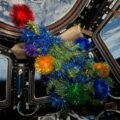This is the second in an ongoing series of updates from Harvard Astronomer Avi Loeb, who heads The Galileo Project, documenting his team’s expedition to attempt the recovery of an interstellar object from the floor of the Pacific Ocean. This entry covers Day 3 (June 13, 2023) of the team’s expedition.
We are on our way to the Pacific Ocean through Australia in search of the materials of the first interstellar meteor, IM1.
My last TV interview before departure inspired a generous and rather unexpected donation of public visibility to the Galileo Project and its expedition. Shortly before my flight, I signed an online agreement with a business owner who secured us airtime on the spectacular, newest high-definition bow-tie Mega Screen in Times Square at 1500 Broadway & W43rd across from 1 Times Square in Manhattan, New York.
Within hours, members of the Galileo Project, led by Daniel Llussa, produced a brief video, which can be previewed at this link. This video will be featured to millions of visitors to Times Square in the coming 3.5 months. The expedition’s goal is to deliver new content to the video by finding interstellar materials. We will update the video in New York City as we make progress on the boat in the Pacific Ocean. If you visit Times Square this summer, check out this digital display.
On my way to the airport, the UK astrophysicist Javier Martin-Torres emailed me the message: “I notice a big change in the US media, public opinion and even government after the start of the Galileo Project. I think that the Galileo Project triggered the fuse that was latent for years…” I replied: “Public opinion is indeed shifting. But finding interstellar material in this expedition could change everything.”
When I entered the jet, the pilot said: “Welcome aboard, Professor Loeb”. I replied: “You can call me Avi. I am just a curious farm boy. Everything else is irrelevant.”
On the jet, I had a long chat with the expedition funder, Charles Hoskinson, about mathematics, computer science, artificial intelligence, de-extinction of genetic materials and the associated revival of lost animals like the woolly mammoth or the Tasmanian tiger, and most importantly – what we might find on the ocean floor. If IM1 was a technological artifact, its core could have survived the atmospheric entry, and the expedition might find a sizable relic of it on the ocean floor. If any operating system in it survived, we could attempt to revive it. “Reconstructing an extraterrestrial operating system might be far more exciting than the revival of the Tasmanian tiger in Australia,” I noted to Charles, who is involved in the latter project.
However, the sobering reality is that a meter-sized object would be difficult to find across a search region of a few kilometers in scale. It is much easier to recover millimeter-sized spherules from their melted exterior since they are far more abundant. Small things are far more abundant than big things; a reasonable expectation in a scale-free disintegration process is an equal amount of total mass per logarithmic bin of fragment mass.
As we flew over Australia’s Great Barrier Reef, I was reminded of the great barrier to the success of the expedition. Fortunately, we have an exceptional team that is passionate about our scientific mission. If we search for IM1 and find nothing, we will try again to look for IM1 and later for the second interstellar candidate, IM2. Outsiders might wonder: what is the point of searching if the chance for success is small? They miss the simple truth that the actual act of pursuing materials from an interstellar package gives a meaningful purpose to our lives. The package may inspire humanity to behave more intelligently on Earth. If others arrive at our doorstep, we might wish to visit them.
As the team approached Australia, my thoughts were echoed by a new email from the playwright Josh Ravetch who noted, “… no century has ever given us a window seat on our cramped little cruise ship. Maybe the bigger idea here is that we know we’re on an island, and there’s no one doing much more than looking out the windows. It may sound hokey, but you’re headed to the Pacific Ocean looking for the rest of our family. These are cousins, not aliens….”.
After arriving, the taxi driver asked the group whether we were filming a television shoot or a science project. The filming director, Jason Kohn, answered: “It depends on who you ask.” I corrected Jason and said: “It is a science project. The cameras would not be here if the scientists were not here, but not vice versa.”
A few minutes later, I received a message from Rob McCallum, the expedition coordinator, who already boarded our boat, fittingly named `Silver Star’. Rob said: “The ship, the crew, the equipment, and arrangements are all in place and synchronized. We are ready for business… We are on the eve of an adventure. I’m so pleased for you as we watch things become operational.”
Avi Loeb is the head of the Galileo Project, founding director of Harvard University’s – Black Hole Initiative, director of the Institute for Theory and Computation at the Harvard-Smithsonian Center for Astrophysics, and the former chair of the astronomy department at Harvard University (2011-2020). He chairs the advisory board for the Breakthrough Starshot project, and is a former member of the President’s Council of Advisors onScience and Technology and a former chair of the Board on Physics and Astronomy of the National Academies. He is the bestselling author of “Extraterrestrial: The First Sign of Intelligent Life Beyond Earth” and a co-author of the textbook “Life in the Cosmos”, both published in 2021. His new book, titled “Interstellar”, is scheduled for publication in August 2023.

